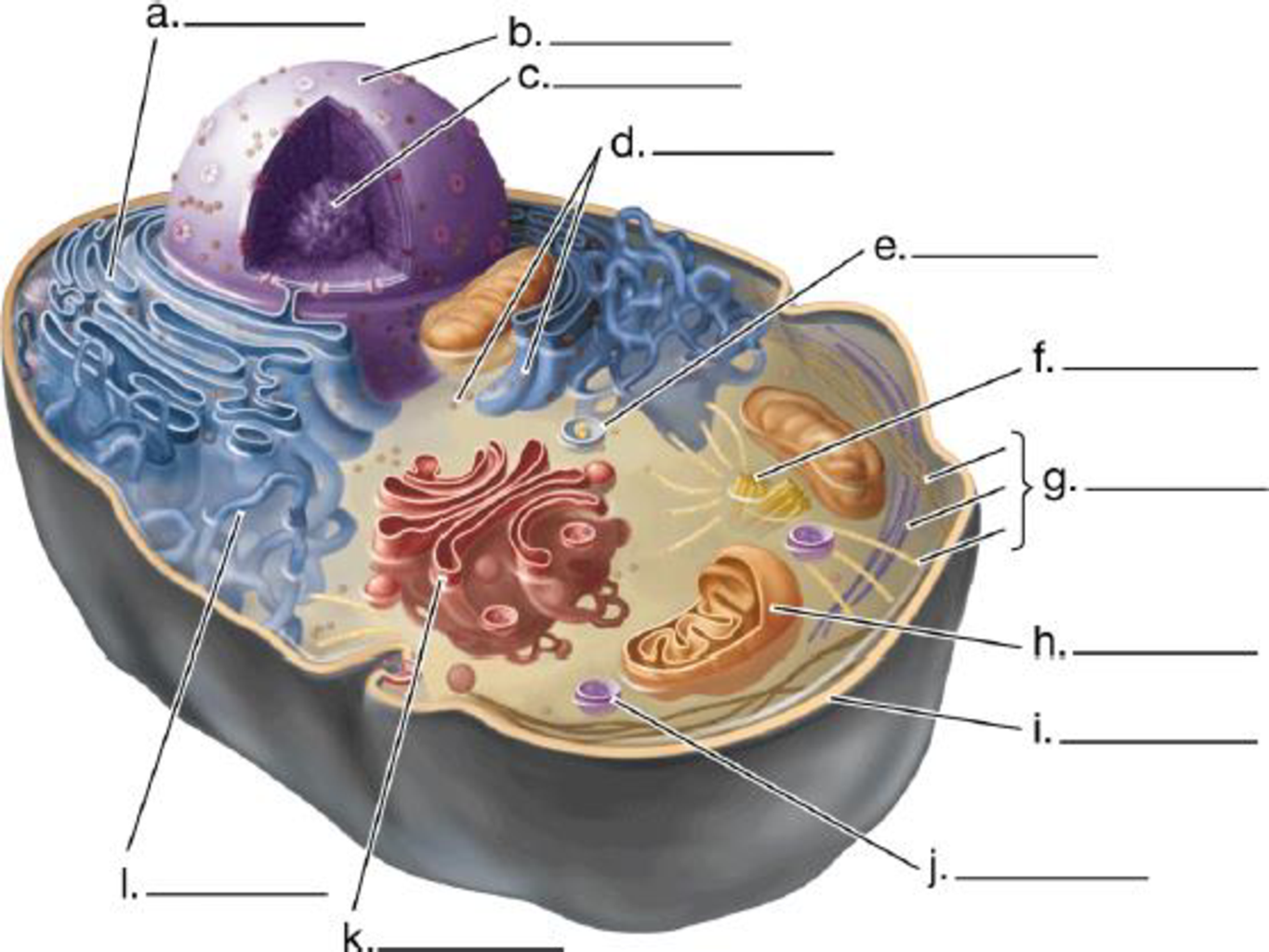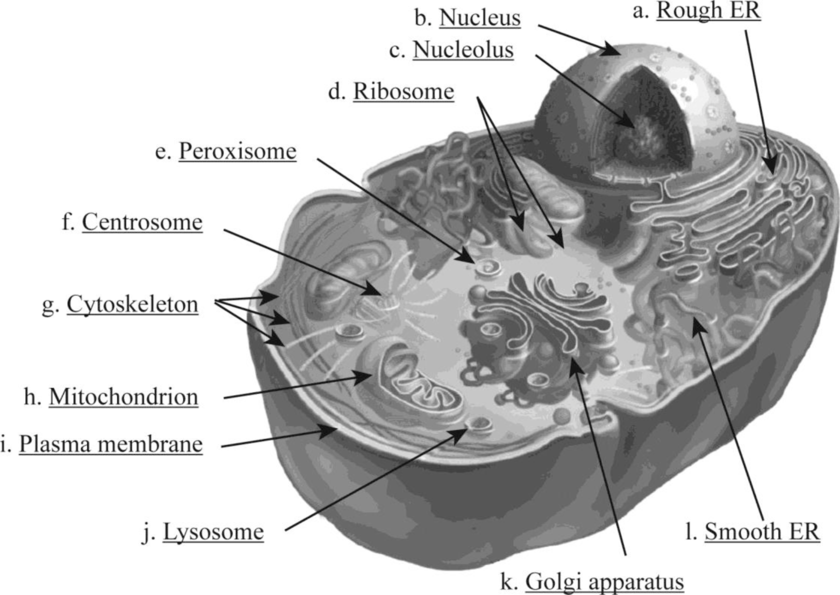
CAMPBELL BIOLOGY:CONCEPTS+CONNECTIONS
10th Edition
ISBN: 9780136538875
Author: Taylor
Publisher: INTER PEAR
expand_more
expand_more
format_list_bulleted
Concept explainers
Textbook Question
Chapter 4, Problem 1CC
Label the structures in this diagram of an animal cell. Review the functions of each of these organelles.

Expert Solution & Answer
Summary Introduction
To review: The structures and functions of each of the organelles in the given animal cell.
Introduction:
A cell is the fundamental structural and functional unit of living organisms. It is bounded by a cell membrane. Cells contain different organelles. Each organelle has its own specific features and functions. Each cellular organelle possesses different structural peculiarities.
Explanation of Solution
Pictorial representation:
Fig. 1 shows various structural organelles of an animal cell.

Fig. 1: Structure of an animal cell
The functions of various organelles are very specific.
- a. Rough ER: It is a network of membranous sacs and tubes; its external surface is attached with the ribosome. It helps in protein processing and secretion. Also, the addition of carbohydrate with protein occurs to produce glycoprotein, which helps in the production of a new membrane within the cell.
- b. Nucleus: It is a membrane-bound organelle covered by the nuclear envelope. The nucleus contains the nucleolus and chromatin material. The chromatin material consists of DNA and proteins.
- c. Nucleolus: It is a core region in the nucleus where components of the ribosome assemble.
- d. Ribosome: It is a non-membranous structure found in the cytoplasm of the cell. It is the core organelle for protein synthesis. It can be found free or attached with the rough endoplasmic reticulum.
- e. Peroxisome: It is a specialized single membrane–bound vesicle found in the cytoplasm of the cell. It produces hydrogen peroxide as a by-product and converts it to water.
- f. Centrosome: The formation of microtubules initiates at the centrosome. It contains a pair of centrioles.
- g. Cytoskeleton: It consists of a network of fibrous substances within the cytoplasm of a cell. The cytoskeleton consists of three main fibers called microtubules, microfilaments, and intermediate filaments. It helps in providing rigidity and gives structural support to the cell.
- h. Mitochondrion: It is double membrane–bound organelle. It is important for cellular respiration and energy generation in the form of ATP. The two phospholipid bilayer membranes enclosed with the mitochondria play a great role in functioning of mitochondria. It is also called as the “power house” of the cell.
- i. Plasma membrane: It is the protective compartment of the cell. It is composed of a lipid bilayer.
- j. Lysosome: It is a single membrane–bound organelle. It is the storage unit of hydrolytic enzymes. Breakdown of indigested substances takes place in lysosomes, and cell organelles are recycled here.
- k. Golgi apparatus: It is a single membrane–bound organelle stack of the flattened membranous sac. It is the active unit of modification, sorting, and secretion of cell products.
- l. Smooth ER: It is a network of membranous sacs and tubes but not attached with the ribosome. It helps in detoxification and lipid synthesis. It helps in folding of protein and transferring of the synthesized protein.
Want to see more full solutions like this?
Subscribe now to access step-by-step solutions to millions of textbook problems written by subject matter experts!
Students have asked these similar questions
When taking vitamins and vitamin-mineral supplements, how can one be sure they are getting what they are taking?
How many milligrams of zinc did you consume on average per day over the 3 days? (See the Actual Intakes vs. Recommended Intakes Report with all days checked.)
Enter the number of milligrams of zinc rounded to the first decimal place in the box below.
______ mg ?
the direct output from molecular replacement is a coordinate file showing the orientation of the unknown target protein in the unit cell. true or false?
Chapter 4 Solutions
CAMPBELL BIOLOGY:CONCEPTS+CONNECTIONS
Ch. 4 - Label the structures in this diagram of an animal...Ch. 4 - Prob. 2TYKCh. 4 - Prob. 3TYKCh. 4 - Which of the following clues would tell you...Ch. 4 - Prob. 5TYKCh. 4 - What four cellular components are shared by...Ch. 4 - Describe two different ways in which cilia can...Ch. 4 - In which cell would you find the most lysosomes?...Ch. 4 - Prob. 9TYKCh. 4 - Prob. 10TYK
Ch. 4 - In which cell would you find the most...Ch. 4 - In what ways do the internal membranes of a...Ch. 4 - Is this statement true or false? Animal cells have...Ch. 4 - Describe the structure of the plasma membrane of...Ch. 4 - Prob. 15TYKCh. 4 - Describe the pathway of the protein hormone...Ch. 4 - How might the phrase ingested but not digested be...Ch. 4 - Cilia are found on cells in almost every organ of...Ch. 4 - SCIENTIFIC THINKING Microtubules often produce...
Knowledge Booster
Learn more about
Need a deep-dive on the concept behind this application? Look no further. Learn more about this topic, biology and related others by exploring similar questions and additional content below.Similar questions
- the direct output from molecular replacement is a coordinate file showing the orientation of the unknown target protein in the unit cell. true or false?arrow_forwardDid your intake of vitamin C meet or come very close to the recommended amount? yes noarrow_forwardWhich of the following statements about hydration is true? Absence of thirst is a reliable indication that an individual is adequately hydrated. All of these statements are true. Although a popular way to monitor hydration status, weighing yourself before and after intensive physical activity is not a reliable method to monitor hydration. Urine that is the color of apple juice indicates dehydration. I don't know yetarrow_forward
- Three of the many recessive mutations in Drosophila melanogaster that affect body color, wing shape, or bristle morphology are black (b) body versus grey in wild type, dumpy (dp), obliquely truncated wings versus long wings in the male, and hooked (hk) bristles versus not hooked in the wild type. From a cross of a dumpy female with a black and hooked male, all of the F1 were wild type for all three of the characters. The testcross of an F1 female with a dumpy, black, hooked male gave the following results: Trait Number of individuals Wild type 169 Black 19 Black, hooked 301 Dumpy, hooked 21 Hooked, dumpy, black 172 Dumpy, black 6 Dumpy 305 Hooked 8 Determine the order of the genes and the mapping distance between genes. Determine the coefficient of confidence for the portion of the chromosome involved in the cross. How much interference takes place in the cross?arrow_forwardWhat happens to a microbes membrane at colder temperature?arrow_forwardGenes at loci f, m, and w are linked, but their order is unknown. The F1 heterozygotes from a cross of FFMMWW x ffmmww are test crossed. The most frequent phenotypes in the test cross progeny will be FMW and fmw regardless of what the gene order turns out to be. What classes of testcross progeny (phenotypes) would be least frequent if locus m is in the middle? What classes would be least frequent if locus f is in the middle? What classes would be least frequent if locus w is in the middle?arrow_forward
- 1. In the following illustration of a phospholipid... (Chemistry Primer and Video 2-2, 2-3 and 2-5) a. Label which chains contain saturated fatty acids and non-saturated fatty acids. b. Label all the areas where the following bonds could form with other molecules which are not shown. i. Hydrogen bonds ii. Ionic Bonds iii. Hydrophobic Interactions 12-6 HICIH HICIH HICHH HICHH HICIH OHHHHHHHHHHHHHHHHH C-C-C-C-C-c-c-c-c-c-c-c-c-c-c-c-C-C-H HH H H H H H H H H H H H H H H H H H HO H-C-O H-C-O- O O-P-O-C-H H T HICIH HICIH HICIH HICIH HHHHHHH HICIH HICIH HICIH 0=C HIC -C-C-C-C-C-C-C-C-CC-C-C-C-C-C-C-C-C-H HHHHHHHHH IIIIIIII HHHHHHHH (e-osbiv)arrow_forwardAnswer this as a dental assistant studentarrow_forwardbuatkan judul skripsi tentang parasitologi yang sedang trendinharrow_forward
- Dental assistantarrow_forwardO Macmillan Learning Glu-His-Trp-Ser-Gly-Leu-Arg-Pro-Gly The pKa values for the peptide's side chains, terminal amino groups, and carboxyl groups are provided in the table. Amino acid Amino pKa Carboxyl pKa Side-chain pKa glutamate 9.60 2.34 histidine 9.17 1.82 4.25 6.00 tryptophan 9.39 2.38 serine 9.15 2.21 glycine 9.60 2.34 leucine 9.60 2.36 arginine 9.04 2.17 12.48 proline 10.96 1.99 Calculate the net charge of the molecule at pH 3. net charge at pH 3: Calculate the net charge of the molecule at pH 8. net charge at pH 8: Calculate the net charge of the molecule at pH 11. net charge at pH 11: Estimate the isoelectric point (pl) for this peptide. pl:arrow_forwardBiology Questionarrow_forward
arrow_back_ios
SEE MORE QUESTIONS
arrow_forward_ios
Recommended textbooks for you
 Human Physiology: From Cells to Systems (MindTap ...BiologyISBN:9781285866932Author:Lauralee SherwoodPublisher:Cengage Learning
Human Physiology: From Cells to Systems (MindTap ...BiologyISBN:9781285866932Author:Lauralee SherwoodPublisher:Cengage Learning
 Biology Today and Tomorrow without Physiology (Mi...BiologyISBN:9781305117396Author:Cecie Starr, Christine Evers, Lisa StarrPublisher:Cengage Learning
Biology Today and Tomorrow without Physiology (Mi...BiologyISBN:9781305117396Author:Cecie Starr, Christine Evers, Lisa StarrPublisher:Cengage Learning


Human Physiology: From Cells to Systems (MindTap ...
Biology
ISBN:9781285866932
Author:Lauralee Sherwood
Publisher:Cengage Learning




Biology Today and Tomorrow without Physiology (Mi...
Biology
ISBN:9781305117396
Author:Cecie Starr, Christine Evers, Lisa Starr
Publisher:Cengage Learning
Dissection Basics | Types and Tools; Author: BlueLink: University of Michigan Anatomy;https://www.youtube.com/watch?v=-_B17pTmzto;License: Standard youtube license